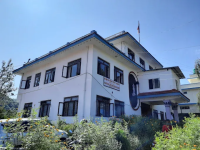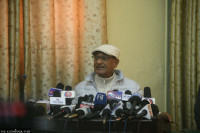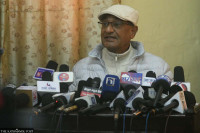National
Endless wait for Korea jobs frustrates youths as they question Nepal’s commitment
Thousands of Nepalis who have passed the tests and got jobs blame government inaction while experts say it could be proactive rather than wait to hear from the Koreans.
Chandan Kumar Mandal
In 2018, Ajay Sodari of Ghodaghodi Municipality, Kailali made a plan to migrate to South Korea. But he was unaware of the time and effort it would require to land a Korean job.
As a first step, Sodari started preparing on his own with whatever study materials he could get online and some Korean language books.
“I thought of going to South Korea, which is an attractive labour destination for Nepali migrants,” said Sodari. “You can do a lot in a short span if you can get a Korean job.”
With such aspirations, Sodari sat the Test of Proficiency in Korean (TOPIK), a mandatory Korean language test for those wanting to work in South Korea. But he could not pass the test in 2018. Sodari moved to Kathmandu to prepare for the test in 2019.
With all the struggle that comes in moving from Kailali to Kathmandu and after nearly eight months of hard work, Sodari did crack the test in 2019, when a record number of over 92,000 applicants had appeared for the examination.
Sodari was among the 6,773 individuals who cleared both the language test and the skill test, which is a test of candidates’ basic understanding of the job sector they are planning to enter, to get a job in Korea in 2020 under the Employment Permit System (EPS).
But then the Covid-19 pandemic struck. It suspended Nepali workers’ migration to the east Asian country for an indefinite period.
There are thousands like Sodari waiting for more than a year now to get to South Korea having passed both the tests.
How long the wait will be is still unclear.
Sodari was even selected by a Korean employer. He had also received his contract from the employer and the Certificate for Confirmation of Visa Issuance, after which, during normal time, candidates must reach Korea within 90 days.
However, after a long-wait of nine months, the Korean employer cancelled the work contract with Sodari.
Labour migration to South Korea has witnessed obstructions since the first week of February last year. Later in the same month, the migration of Nepali youths to South Korea was temporarily halted as South Korea became an epicentre of Covid-19.
Since then, although labour migration to other countries has resumed, departures of Nepali candidates to South Korea remain suspended.
Bhim Raj Bhatta from Melauli Municipality, Baitadi was also selected to go to Korean in 2020. Like Sodari, he also started preparing for the language test in 2018 from home and cleared the test in 2019 after moving to Kathmandu.
“I worked in Kathmandu so that I could learn the Korean language. I would work in the daytime and study at night,” said Bhatta, 24. “The dream was to reach South Korea and do something for the family.”
Bhatta does not know what he should be doing as he waits for his long-held dream to become reality.
“I am confused about what I should be doing. What if I give up and start doing something else and then migration to South Korea resumes?” said Bhatta. “If I start my own business, then I would again need to take loans as I come from a middle-class family. The government should at least clearly tell us whether we are going or not.”
According to Nepal government statistics, more than 65,000 Nepali workers have gone to South Korea since 2008 under the EPS. The East Asian country remains the preferred labour destination country for aspiring Nepali migrants for its better pay, safety and other facilities compared to destination countries in the Persian Gulf.
Starting from January 2021, the minimum wage in South Korea has been hiked by 1.5 percent from South Korean won 8,590 per hour to 8,720 (approximately Rs892) per hour.
If a labourer works 209 hours every month, the labourer can now earn 1,822,480 won (or around Rs 186,398). The minimum new wage in the country is applied to all industries.
Meanwhile, people like Sodari and Bhatta have been thronging the government agencies like the Ministry of Labour, Employment and Social Security, Department of Foreign Employment and Employment Permit System (EPS) Korea Section to inquire about their prospects of reaching South Korea.
They have even formed ‘EPS Victims Family’, a loose group of over 100 candidates, under Sodari’s leadership to put pressure on these agencies so that they can get to South Korea at the earliest. In July last year, frustrated with the delay, they even protested at Maitighar Mandala.
There are nearly 8,000 Nepali workers, including first-timers and returnees, who have contracts for the second stints in Korea, waiting, according to government data.
Prakash Shrestha from Ramechhap had returned home in December 2019 during a job break. He had the option of rejoining the same job after his leave.
“I had signed the contract that I would return in three months. I wanted to return as it is a well-paying job. I could again work for four years and ten months,” said Shrestha, who has been living in Kathmandu doing nothing for nearly a year now. “While I have been spending my hard-earned money in Nepal, the government should clearly say whether we would ever reach Korea or not.”
However, so far, Sodari, Bhatta, Shrestha and thousands of others do not see any light at the end of the tunnel.
All they hear from the authorities is the message of ‘wait and see’.
According to Kumar Prasad Dahal, director general at the Department of Foreign Employment, although Nepalis’ migration to South Korea has been halted for a long time, there has been no change in policy, meaning they can still go.
“The Covid-19 pandemic affected the migration to South Korea,” said Dahal. “But as there are no policy barriers, we hope that some candidates will be sent this month or the next.”
South Korea has started taking workers from Vietnam and Cambodia through sampling, according to Dahal.
“But Nepal is still placed among high-risk countries, and therefore, Nepali workers’ departures have not resumed yet,” he added.
Government authorities have been saying that it’s the South Korean side that has not allowed Nepali workers to enter the country.
“Despite having a government-to-government agreement deal with the Korean government, demand for workers has to come from the private sector. If they do not demand our workers, then the government cannot do anything,” said Dahal. “Once the demand pours in, they have to take our workers.”
But if Shrestha’s case is anything to go by there is still demand for Nepali workers.
“The company has been sending me texts repeatedly asking when I would join,” he told the Post.
Like thousands of other workers, Shrestha is also worried that prolonged uncertainty might cost him his job in South Korea.
“Contracts of around 40 percent of workers who wanted to return to my company have been cancelled as they could not report on time. The employer cannot wait for months,” said Shrestha. “I fear the same for myself.”
When the Post reached out to the South Korean Embassy in Kathmandu to inquire over the ongoing delay in sending workers, they refused to talk and instead suggested consulting with the EPS Centre, the Nepal chapter of the Human Resources Development Service, South Korea.
The EPS Centre, in return, did not comment and asked the Post to talk to the Employment Permit System (EPS) Korea Section under the Department of Foreign Employment.
But labour migration experts and aspiring migrants say that while the host government could be on ‘wait and see’ mode before allowing Nepali workers in, the Nepal government could have taken the required initiative all these months.
“First of all, we have to see whether our government is even interested in sending these workers,” said Swarna Kumar Jha, a migration expert who is also a coordinator of the National Network for Safe Migration. “If it is, then there could be a diplomatic intervention.”
Candidates too blame it on the government’s failure to negotiate diplomatically with the Korean government.
“All they give is a readymade answer that it will resume soon and they are waiting for a response from Korean authorities,” said Sodari. “The bureaucrats alone cannot do much unless the labour minister or the foreign minister or even the prime minister steps in to resolve our issues.”
Dahal agrees that a diplomatic resolution could speed up the issue.
“A high-level diplomatic discussion could possibly lead to removing Nepal from high-risk countries and resumption of Nepali workers’ departure,” said Dahal.
But experts say the ongoing political instability means that the government has not been able to focus.
“Recent political upheavals, change of leadership in the Labour Ministry with the new minister and secretary and relations between the political leadership and bureaucrats must have affected the whole scenario,” said Jha. “A G2G deal in supplying Nepali workers makes it even easier to discuss the matter at a high level, if not physically then virtually. The Nepali mission in South Korea must be taking its initiatives, but at times such a decision should also come from the Nepal government or a high level, which does not seem to have happened.”
Meanwhile, workers like Sodari have no option but to wait. The wait so far has already been long enough.
“I had to take loans to fund my Korean language preparation and stay in Kathmandu. I invested tens of thousands of rupees and worked hard for eight months,” said Sodari. “Starting from 2018, I have already spent three years for the Korean job. I never knew it would take so long. My family members and I are frustrated over the future of my job.”




 14.12°C Kathmandu
14.12°C Kathmandu













%20(1).jpg&w=300&height=200)

